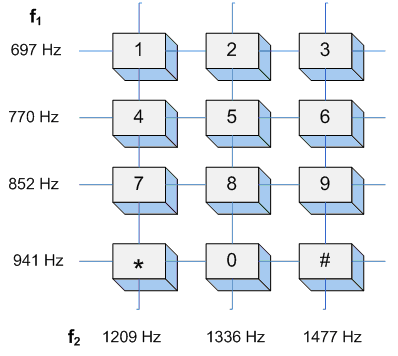| << Chapter < Page | Chapter >> Page > |

[link] and [link] illustrates the front panel of the above transformation system. It shows the Analog signal and Discrete signal in the time and frequency domains using two waveform graphs. The transformation type is also shown in the front panel for both of the signals.
Now let us examine a DFT application. In a touch-tone dialing system, the pressing of each button generates a unique set of two-tone signals, called dual-tone multi-frequency (DTMF) signals. A telephone central office processes these signals to identify the number a user presses. The tone frequency assignments for touch-tone dialing are shown in [link] .

The sound heard when a key is pressed is a signal composed of two sine waves. That is
For example, when a caller presses 1, the corresponding signal is
Other than touch-tone signals, modern telephone systems use DTMF event signals for dial tone, busy tone and ringing tone. Table 1 lists the frequency and timing for standard DTMF event signals.
| Tone type | Frequency | Timing |
| Dial tone | 350 and 440 Hz | Continuous |
| Ringing tone | 480 and 620 Hz | Repeating cycles of 2 s on, 4 s off |
| Busy tone | 480 and 620 Hz | 0.5 s on, 0.5 s off |
In this application, let us examine the touch-tone dialing system of a digital telephone. Ten input variables are assigned to the telephone keys . Each input is connected to a Boolean control. Different types of Boolean controls can be created on the front panel. For this application, use OK Buttons (Controls → Modern → Boolean → OK) , each of which is marked with a number from 0 to 9. The selected operation properties of an OK Button is “Switch until released,” as shown in [link] . This ensures that the corresponding signal gets generated when a key is pressed and gets back into its initial position when the key is released.

Use another input variable, , to act as a counter to count the number of times the keys are pressed. At the beginning, when no key is pressed, the value of is zero and the system returns the dial tone (350 and 440 Hz continuous tone). When the value of is equal to 10, meaning that the keys were pressed for a total of 10 times, the system assumes that a valid phone number is dialed and returns the busy tone or ringing tone. Connect all the Boolean inputs to a Compound Arithmatic function (Functions → Programming → Boolean → Compound Arithmatic) and select the OR mode. The output of this function becomes true(1) if any number key is pressed. The result is connected to the Case selector input of a case structure. The input variableis also connected to the case structure. For true case, is connected to an Increment function (Functions → Programming → Numeric → Increment) and for the false case, it is kept unchanged. The entire system is wrapped inside a W hile L oop (Functions → Programming → Structures → While Loop) . The output of the case structure is then connected to a Greater or Equal function (Functions → Programming → Comparison → Greater or Equal) to ensure that the program exits from the while loop whenis greater than or equal to 10. The system shows the ringing tone or busy tone in the graph and plays the waveform. [link] shows the completed block diagram of the touch-tone telephone system.

Notification Switch
Would you like to follow the 'An interactive approach to signals and systems laboratory' conversation and receive update notifications?